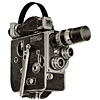
THE PAILLARD-BOLEX CAMERA
December 01, 2005 -- Michael Tisdale
Did you know there were over 50 different types of camera models sold by Paillard-Bolex
from 1935-1969? Most of these were just minor modifications to earlier models;
others were the 8mm equivalent of the 16mm version. Some were simply marketing
terms used to sell cameras at a more affordable cost, such as the Leader or
Standard.
If you browse through the Camera section of this website, you'll see a chronological list of Paillard-Bolex 8mm and 16mm cameras. If you're not familiar with Bolex, it may appear as a confusing list of similarly named models. Trying to identify a particular camera can sometimes be even more confusing.
However, all of them fall roughly into five types: The model H (non-reflex and reflex), which was designed for the professional and serious amateur filmmaker; The "pocket size" camera, intended mostly for home movies; The Zoom Reflex, which was a later series of home movie equipment with more features and automation; and the Super 8 line of home movie cameras.

Model H Non-Reflex
The H series of cameras were spring-wound and accepted 100ft
spools of daylight loading film. On non-reflex cameras, sighting and framing
of the subject was accomplished with a parallax corrected viewfinder attached
to the film chamber door.
16mm non reflex H cameras included: Bolex H-16, H-16 Leader, H-16 Standard, H-16 Deluxe, H-16 Supreme, H-16 T, H-16 M, H-16 M-3, H-16 S, H-16 M-4 and the H-16 M-5.*
Double run 8mm non-reflex H cameras included: the Bolex H-8, H-8 Leader, H-8 Standard, H-8 Deluxe, H-8 T and the H-8 S.
The 9.5mm Bolex H-9 appears to have only been manufactured as a non-reflex camera.

Model H Reflex
Reflex cameras featured through-the-lens viewing and focusing with a beam-splitting prism that diverted light into the viewfinder. Like the other cameras in the H series, they accepted 100ft film loads and were spring-wound with a clockwork motor.
16mm reflex H cameras included: the H-16 Reflex, H-16 REX, H-16 REX-2, H-16 REX-3, H-16 REX-4 and the H-16 REX-5. *
Double run 8mm reflex cameras included the H-8 REX, H-8 REX-3 and H-8 REX 4.

Pocket Size Cameras
These small spring-wound cameras accepted 25ft spools of double run 8mm film. They featured interchangeable lenses; some with a single lens, and others with a twin or triple-mount turret. Later models included a photo-electric selenium cell with through-the-lens exposure metering.
Pocket Size cameras included the Bolex L-8 (and later model L-8), B-8, C-8, B-8VS, B-8L, C-8S, B-8SL, C-8SL, D-8L, B-8LA, C-8LA and D-8LA.

Zoom Reflex Series
The Zoom Reflex series featured built-in zoom lenses with reflex viewing. They were spring wound cameras that accepted 25ft daylight loading spools of double run 8mm film. The Zoom Reflex P1, P2 and P3 were the first in the series, with body construction resembling that of earlier pocket size cameras.
The Bolex Zoom Reflex Automatic series featured a larger body, a built-in hand grip and battery powered automatic diaphragm. The Automatic series included the K-1, K-2, S-1 and P-4.

Super 8
Kodak introduced the Super 8 film format in 1965, but it wasn't until 1967 that the first Bolex super 8 cameras were introduced. Paillard manufactured the alkaline battery powered 150, 155, 7.5 and 160 cameras in Switzerland, at the Ste-Croix factory.
In 1969, Paillard had merged with Eumig of Wein, Austria. A large range of sound and silent Super 8 cameras were subsequently manufactured under the name "Bolex International S.A" by the factories of Eumig, in Austria, and Chinon in Japan throughout the 1970s.
* The H-16 M-5 and H-16 REX-5 had a saddle that allowed for the attachment of 400' capacity magazine loads of 16mm film, in addition to accepting 100' daylight loading spools.

